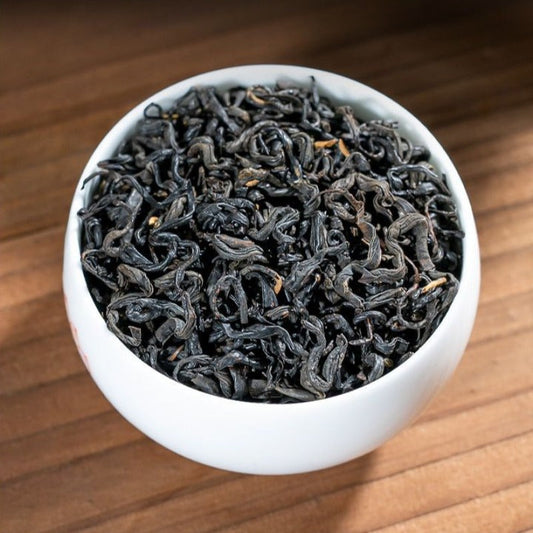Keemun Black Tea: The Regal Elegance of a Thousand Years
—A Tasting Guide & Cultural Appreciation
I. Legendary Origins: The Eastern Heritage of the "Queen of Black Teas"
Keemun Black Tea, born in Qimen County, Anhui, China, stands proudly among the "World’s Three Great Aromatic Black Teas" alongside India’s Darjeeling and Sri Lanka’s Uva. Created during the Qing Dynasty’s Guangxu era, its signature "Keemun Fragrance"—a mesmerizing blend of rose-honey sweetness and orchid notes—captivated European royalty, earning its place as the "Burgundy of Teas" in British afternoon tea culture.
Core Production Zone:
· Authentic Keemun is made exclusively from the Zhuye varietal, grown at 600-800m elevation in Huangshan’s misty microclimate, where rocky soil imparts unparalleled depth.
II. Tasting Guide: A Sensory Journey
1. Observe the Leaves
· Traditional Keemun Congou: Slender, tightly twisted strips with jet-black luster and golden tips (over 30% in premium grades).
· Modern Keemun Spiral/ Mao Feng: Curled like seashells or unfurled buds, showcasing warmer russet hues.
2. Inhale the Aroma
· Dry Leaves: Cool sniff reveals honeyed sweetness; warm exhale unveils orchid and sandalwood.
· Brewed: Initial caramel bursts into stewed apple, finishing with a whisper of pine smoke (a hallmark of traditional charcoal roasting).
3. Admire the Liquor
· Translucent amber with a golden halo (signifying high theaflavin content).
4. Savor the Taste
· Silky texture coats the palate, balancing malty sweetness with a longan-like finish.
· Pro Tasting Terms:
o Astringency: A fleeting 3-second grip that melts into sweetness.
o "Cooling Cloud": Chilled tea develops a creamy haze—proof of rich polyphenols and caffeine synergy.
5. Inspect the Spent Leaves
· Coppery and supple, with even fermentation and no green traces.
III. Flavor Alchemy: Craftsmanship Defines Character
· Traditional Process: Withering → Rolling → Oxidation → Charcoal Baking (for the iconic "Keemun Fragrance").
· Modern Variations: Floral Keemun uses lighter oxidation and low-temperature drying to highlight gardenia notes.
Grading Standards (GB/T 13738.2):
· Superfine: All buds or "one bud, one leaf," densely gilded.
· Grade 1–3: Increasing leaf proportion, bolder in body.
IV. Brewing Rituals: East-Meets-West Ceremony
1. Gongfu-Style (Chinese Artistry)
· Vessel: Porcelain gaiwan or small zisha teapot (red clay enhances aroma).
· Water: 90–95°C (avoid scalding delicate buds).
· Technique: Spiral pour, 5s first infusion, +3s per subsequent steep.
2. Western Infusion
· Classic: 3g tea + 100°C water (3min steep), then milk (fat amplifies caramel notes).
· Creative Twist: Add orange peel or vanilla pod for Victorian-era flair.
V. Aging Potential: Time as an Alchemist
· Storage: Foil-lined bags + ceramic jars, away from moisture/odors.
· Transformation: After 3–5 years, top-grade Keemun develops date and herbal notes, with a rounder mouthfeel.
Epilogue:
Keemun is poetry in a cup—a bridge from Qing-dynasty tea caravans to London’s gilded salons. Whether sipped solo amid falling leaves or shared with tales of its "golden-rimmed" legacy, this crimson elixir remains China’s most refined ambassador.
(Visual storytelling suggestion: Hand-drawn illustrations of Huizhou architecture, a side-by-side of Wedgwood china and blue-white porcelain, or a tea-leaf anatomy diagram.)

![Premium Anhui [Keemun Black Tea] Canned Gift Set 250/500g - YIQIN TEA HOUSE | yiqinteahouse.com | black tea, keemun black tea, tea](http://yiqinteahouse.com/cdn/shop/files/0b3a1c311a4718d81052993e0d611f66.jpg?v=1735969273&width=533)

